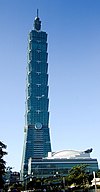Hsinchu Science Park
You can help expand this article with text translated from the corresponding article in Chinese. (March 2019) Click [show] for important translation instructions.
|
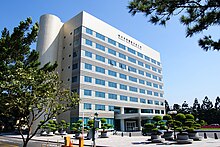 Hsinchu Science Park administration building | |
| Opening date | 1980 |
|---|---|
| Size | 1,400 hectares |
| Website | www.sipa.gov.tw |
The Hsinchu Science Park (HSP; traditional Chinese: 新竹科學園區; simplified Chinese: 新竹科学园区; pinyin: Xīnzhú Kēxué Yuánqū; Pe̍h-ōe-jī: Sin-tek Kho-ha̍k Kang-gia̍p Hn̂g-khu) is an industrial park established by the government of Taiwan on 15 December 1980. It straddles Hsinchu City and Hsinchu County in Taiwan.
History
[edit]The idea of the establishment of the Hsinchu Science Park was first proposed by Shu Shien-Siu, the former President of National Tsing Hua University and Minister of Science and Technology.[1] After Shu became the Minister of Science and Technology in 1973, he traveled to the United States, Europe, and Japan to learn and study their conditions of the development of science and technology. In 1976, Shu came up with the idea of building a science and technology park like that of Silicon Valley.[1] President Chiang Ching-kuo proposed to build the park in Longtan District because of the potential future benefits that could be drawn from National Chung-Shan Institute of Science and Technology and the military. However, Shu argued that the technology and science park should not be close to the military as the primary goal of the founding of the park is to expand the size of private economy and creative vitality of Taiwan. Shu's idea was to build the park in Hsinchu next to the National Tsing Hua University and the (then) National Chiao Tung University like the Silicon Valley, which is adjacent to Stanford University and University of California, Berkeley. Shu's idea was ultimately approved by Chiang and the park was built and opened in 1980 in Hsinchu.[2]
After the original idea of the establishment of the science park and the location of the park were settled, Chiang Ching-kuo assigned the task of constructing the Hsinchu Science Park. Irving Tze Ho (何宜慈) (1921–2003)[3][4][5][6] was tasked to set up the park in 1979 and serve as its first director. Li Kwoh-ting, former Finance Minister of the Republic of China, was among those who significantly contributed to the founding of the park, as ordered by Chiang.[7] Inspired by Silicon Valley, Li consulted Frederick Terman on how Taiwan could follow its example. From there, Li convinced talents who had gone abroad to build companies in this new Silicon Valley in Taiwan. Among those who returned is Morris Chang, who later led the Industrial Technology Research Institute (ITRI) and founded TSMC. Li also introduced the concept of venture capital to the country to attract funds to finance high-tech startups in Taiwan.
Overview
[edit]The park houses more than 400 high-tech companies, mainly involved in the semiconductor, computer, telecommunication, and optoelectronics industries, have been established in the park since the end of December 2003.[8] Its 400 technology companies accounted for 10% of Taiwan's gross domestic product in 2007. It is home to the world's top two semiconductor foundries, Taiwan Semiconductor Manufacturing Company (TSMC) and United Microelectronics Corporation (UMC), both of which were established at the nearby Industrial Technology Research Institute. Taiwan is the only country that possesses a professional division-of-labor system in the semiconductor industry and also has the highest density of 12-inch wafer-producing fabs, most of which are based in the park.[9] Next door to the science park are two of Taiwan's science and engineering powerhouses, National Yang Ming Chiao Tung University and National Tsing Hua University, and the National Space Organization, the Taiwanese space agency, are located in the park.
There were local residents' protests against water and air pollution. The Park's industrial wastewater treatment plant[10] began to operate in 1986 and effectively treats wastewater for maximum safety while Taiwan's National Environmental Protection Department monitors the air quality in the park and surrounding areas to maintain clean air quality.
Locations
[edit]Currently, the Hsinchu Science Park covers six locations, with a total development area of 1,471 hectares:[11]
- Hsinchu Science Park in East District, Hsinchu City and Baoshan, Hsinchu County
- Zhunan Science Park in Zhunan, Miaoli County
- Longtan Science Park in Longtan District, Taoyuan
- Tongluo Science Park in Tongluo Township, Miaoli County
- Yilan Science Park in Yilan City, Yilan County
- Biomedical Science Park in Zhubei, Hsinchu County
Major companies located in the park
[edit]

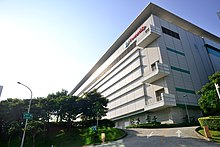

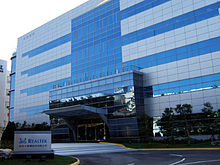
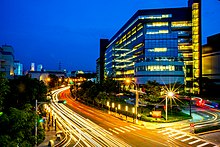
- Acer Inc.
- Apple Inc.[12]
- Applied Materials
- Axtronics Inc.
- Alpha Networks Inc.
- AU Optronics
- ChipMOS TECHNOLOGIES, LTD. (IMOS)
- Chimei Innolux
- Cadence Design Systems
- Coretronic
- Epistar
- Elan Microelectronics Corporation
- Global Unichip Corporation
- Hermes-Epitek
- Holtek
- Kingston Technology
- Lam Research
- Lite-On
- Logitech
- Macronix International[13] (MXIC)
- MediaTek
- Microtek
- MiTAC
- MStar Semiconductor
- MA-tek Inc.
- Novatek
- Nuvoton Technology Corp.
- Optodisc
- Philips
- Powerchip Semiconductor[14] (PSC)
- ProMOS Technologies[15]
- Qualcomm
- Realtek
- Silicon Integrated Systems
- Shin-Etsu Chemical
- SMOBIO Technology, Inc.[16]
- Sunplus
- Source Photonics
- Tecom - Tecom Co., Ltd
- Tokyo Electron
- TSMC - Taiwan Semiconductor Manufacturing Company Ltd.
- United Microelectronics Corporation
- Vanguard International Semiconductor Corporation
- Wistron
- Winbond
- ZyXEL[17]
See also
[edit]- Business cluster
- Economy of Taiwan
- Mega-Site
- Southern Taiwan Science Park
- National Experimental High School: A K-12 school established to provide special education opportunity to personnel of Greater Science Park Area.
References
[edit]- ^ a b 張, 仲瑋. "淺談前校長徐賢修先生" (PDF). Retrieved 2015-05-31.
- ^ 志仁, 王. "散播科技聚落的基因 徐賢修". 天下雜誌. 天下雜誌. Retrieved 2015-09-15.
- ^ "Scientist Given Task To Set Up Science-Oriented Industrial Park". Science Bulletin. Vol. 11, no. 2. Taipei, Taiwan: National Science Council. 1979-02-01. p. 1. ISSN 1607-3509. OCLC 1658005. Archived from the original on 2020-06-25. Retrieved 2020-06-24. (1 page) [1]
- ^ Tseng, Li-Ling (1988-04-01). "High-Tech Leadership: Irving T. Ho". Taiwan Info. Archived from the original on 2016-02-08. Retrieved 2016-02-08. [2]
- ^ "Taiwan's Silicon Valley: The Evolution of Hsinchu Industrial Park". Freeman Spogli Institute for International Studies. Stanford University, Stanford, California, USA. 2000-01-11. Archived from the original on 2020-06-26. Retrieved 2017-05-02.
- ^ "Irving T. Ho". San Jose Mercury News. 2003-04-26. Archived from the original on 2020-06-25. Retrieved 2020-06-25.
- ^ 企劃組 (2017-01-16). "壹、科學園區的推手". Retrieved 2017-01-16.
- ^ Central News Agency (2007-06-26). "Hsinchu Science Park export value grows, large growth for optoelectronics". Department of Investment Services (Taiwan). MOEA.
- ^ National Science Council (2005). "Hsinchu Science Park". Government of Taiwan. Archived from the original on 2008-12-18. Retrieved 2008-12-07.
- ^ "園區污水處理廠介紹". Archived from the original on 2012-07-13. Retrieved 2017-01-16.
- ^ "Hsinchu Science Park". Retrieved 2017-01-16.
- ^ Aspinwall, Nick. "Taiwan Chipmaker Announces US Factory as Apple Pledges to Expand Taiwan Investment". thediplomat.com. The Diplomat. Retrieved 2020-05-15.
- ^ "Macronix - Nonvolatile Memory Solutions". Archived from the original on 2008-09-08. Retrieved 2017-01-16.
- ^ 力晶科技股份有限公司. "力晶科技股份有限公司". Retrieved 2017-01-16.
- ^ "::Welcome to ProMOS Technologies Website::". Archived from the original on 2012-03-04. Retrieved 2017-01-16.
- ^ "SMOBIO-index". Retrieved 2017-01-16.
- ^ National Science Council (2005). "Hsinchu Science Park". Government of Taiwan. Archived from the original on 2008-12-18. Retrieved 2008-12-07.

